Advertisement
Parsing The New York Times Story On Benghazi
Resume
A New York Times investigative piece offers new information about what happened during the attacks in Benghazi on September 11, 2012 that left Ambassador Christopher Stevens and three others dead.
In the article, David D. Kirkpatrick, the Times' Cairo bureau chief writes:
"Months of investigation by The New York Times, centered on extensive interviews with Libyans in Benghazi who had direct knowledge of the attack there and its context, turned up no evidence that Al Qaeda or other international terrorist groups had any role in the assault. The attack was led, instead, by fighters who had benefited directly from NATO’s extensive air power and logistics support during the uprising against Colonel Qaddafi. And contrary to claims by some members of Congress, it was fueled in large part by anger at an American-made video denigrating Islam."
Here & Now's Robin Young speaks with Anthony Cordesman, chair in strategy at the Center for Strategic and International Studies, to parse out the Times' lengthy report.
NPR's Ron Elving then joins Here & Now's Meghan Chakrabarti to discuss the political implications of these new revelations.
Guests
- Anthony Cordesman, chair in strategy at the Center for Strategic and International Studies.
- Ron Elving, senior Washington editor for NPR. He tweets @relving.
This segment aired on December 30, 2013.